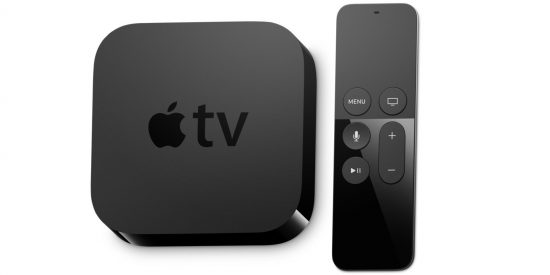Putting itself in the center.
The veil of secrecy might be slipping or maybe CEO Tim Cook likes to let it slip for a seductive peek or two, because well before the start of this year’s Fall keynote we all knew we were in for a $1,000 Apple iPhone. That’s the kind of news people like to be braced for. Most computers don’t even cost $1,000. Most people also knew a new version of the Watch was on the way as well. But as always, with Apple announcements, the show’s the thing.
The fact of the matter is, the $1,000 price point for a new iPhone wasn’t the only barrier shattered and Apple has a clear runway to further define its growing corner of the technology world with an interconnected lineup of consumer devices.
First there’s the Apple TV, oh so ho hum, the world has been waiting for a significant update to Apple TV so long that the world kinda forgot about it and kept spinning anyway. Most of the world is going to continue to live without the Apple TV, but those people who can and do step up are also going to be buying more expensive TVs and more content because the Apple store is offering 4K UHD content at no extra premium.

The Apple TV is also another doorway to the connected home allowing you to lock all the smart locks, adjust the lights, set the temperature and snuggle down on the couch to watch TV. The Apple vision is to connect all the iDevices in a home ecosystem. Apple TV is also available on the iPad and the iPhone, Siri is authorized to turn on the lights, change the music, or even find a TV show across all the devices all through the magic of HomeKit, which has taken its time arriving but promises to be transformational for the home automation market. It’s a pretty slick end run around Alexa, and we can’t wait to see what Amazon comes up with to combat it. The other competitors such as Nvidia Shield, and Google Home are going to have an even harder time catching up to Apple’s head start with devices, services, and a big base of iProduct owners.
Apple doesn’t talk much about the addition of the 64-bit A10X processor to Apple TV, but the same processor that now powers the iPad Pro enables 4K HDR and also support for Dolby Vision, HDR10, and the video scaler that improves HD content.
Listen to the Watch
The Apple Watch, formerly a quirky adjunct to the phone, has come in to its own as a full-fledged, standalone device. It has its own WiFi (but it will not require a new wireless account) so it can send and receive calls without an iPhone—giving those who haven’t flipped yet, a really good reason to buy Apple Air Pods. Apple has expanded the fitness features to support swimming (it’s now waterproof) also to interact with fitness machines that have a built-in GymKit app. The watch also promises to keep track of wearers’ heartrates and issue an alert in case of an anomalous spike or drop.
There should be absolutely no surprise that the new Watch will allow Apple Music subscribers to access their music anytime anywhere. There’s no word about official Apple support for other services such as Spotify or Pandora. Though Spotify is supposedly working on an app for the Watch.
Tech advances
Apple’s latest phones are the company’s biggest news. They’re the hub of the Apple device network for consumers. What we’re really interested is the new chip that will power the phones, the A11 processor, the Bionic chipset. The headlines provided by Apple say the Bionic chipset, developed under the leadership of Apple VP Johny Srouji, includes a six-core CPU, six-core GPU, and M11 motion co-processor, as well as an ISP, and Neural Engine. According to industry reports, the chip has 4.3 billion transistors and was manufactured in TSMC’s 10 nm process.
| iPhone X | iPhone 8 Plus | iPhone 8 | |
| Display | Super Retina 5.8 HD | 5.5 inch Retina | 4.7 inch Retina HD |
| Camera | 12 MP wide-angle/telephoto cameras | 12 MP wide-angle and telephoto cameras | 12 MP camera |
| Lenses | wide angle f/1.8 f2.4 telephoto | wide angle f/1.8 f2.8 aperture | f1.8 aperture |
| portrait mode | portrait mode | X | |
| Security | Face ID | Touch ID | Touch ID |
| Processor | A11 Bionic Chip | A11 Bionic Chip | A 11 Bionic Chip |
| Neural Engine | Neural Engine | Neural Engine | |
| Embedded M11 motion coprocessor | Embedded M11 motion coprocessor | Embedded M11 motion coprocessor | |
| 3 GB Ram | 3 GB Ram | 2 GB Ram | |
| Charging | Qi wireless charging | Qi wireless charging | Qi wireless charging |
With the iPhone 8, Apple unveiled its own GPU technology and promised to keep developing so that it no longer needs Imagination’s technology. Apple’s new GPU, like the GPU in the A10 has 6 CPU cores, uses tile-based deferred rendering (TBDR) which improves rendering speeds and power consumption. Tile-based deferred rendering is a technology long associated with Imagination, though Imagination was not the only company to use it. There is still some Imagination technology being used in the A11. It is directly optimized by Apple’s Metal API. Apple talks about this on its developer pages though the company is pretty vague about where the tile rendering technology has come from. The architecture separates the vertex processing and the fragment processing so they can run asynchronously instead of having the fragment processor wait for the vertex processing. Metal enables the GPUs to efficiently use the processor’s local tile memory, rather than having to send tiles to external memory for processing.
In addition to the GPU and CPU, Apple has also added what it calls the Neural Engine to its ISP (Image Signal Processor). The job of the Neural Processor is to perform machine learning tasks with matching and analysis using the image data coming from the camera sensor. The Neural Engine does its job and offloads the GPU. Benefits of the Neural Processor include object identification, tracking, and focus. In our view, the Neural Engine is a VPU (visual processor unit) as covered in our quarterly report on VPUs.
Apple says in all its A11 processor is 25% faster than its predecessor and 70% more efficient.
Because of the legal spat between Apple and Qualcomm, Apple is using both Qualcomm and Intel modems in its new phones. In order to keep the capabilities of models the same, the phones will offer Advanced LTE, but they won’t get Qualcomm’s Gigabit LTE when that becomes available in order to keep the specs equal on all phones.
Getting depth
The iPhone X is the line in the sand for Apple. It’s striking with a full screen the stretches top to bottom and side to side—very similar, some might say, to the Samsung Infinity display, which actually curves around the edges. The iPhone X doesn’t have an on–off button to break the flow of glass; instead users turn it on by looking at the phone. With this phone Apple is poised to unleash the technology it acquired with Prime Sense in 2014. It is also using Apple’s new processing architecture in the A11. The iPhone X has a 3D sensor in addition to its other sensors which enables it to build a fast model of someone’s face and use it to ID where the person looking at the phone is its owner.
Apple’s Face ID works with the front-facing TrueDepth camera, and projects and analyzes more than 30,000 invisible dots to create a precise depth map of the face. Once set up, your face is your password. In addition to opening the phone, you can also pay using Apple pay and authenticate that you are you. Apple has acquired facial recognition technology over the years including RealFace in 2017, Emotient in 2016, and LinX.
It was strange that among the fancy talents iPhone X has to show off, AR got such short shrift. There are not a lot of phones on the market with 3D sensors; the first two were the Lenovo Phab 2 Pro and the Asus Zenphone AR. Those phones use the 3D sensor with the outward facing camera and they aren’t setting the world on fire. The problem seems to be a dearth of apps. It’s a problem that plagued the Microsoft and Sony with their game consoles, Intel with RealSense, and Google with Tango. The Hololens is going after professional applications to start, which makes sense. AR as a professional tool will be a growth market with a long runway. We expect to see more acquisitions and more hiring from Apple in the field of AR and AI.
But, Apple’s 3D sensor is front-facing and used for face sensing only, which is a little surprising since there seems to be so much potential in a back-mounted 3D sensing camera for AR.

Along those lines, we just heard about Apple’s acquisition of Regaind. Apple hasn’t said anything about it, other than the usual official we’re not gonna talk about it statement. The company was in the early stages of start up, with a modest investment of around $500,000 from Side Capital. The company has been developing a computer-vision AI. In an article, TechCrunch speculates that Regained was acquired to beef up Apple’s PhotoSearch tools which were introduced in 2015.
Regaind’s computer-vision tools analyze the content of photos and also make judgements on the technical aspects and aesthetic values of photos. It can also identify and hide duplicates. Regaind also analyzes photos to sort gender, age, and emotions.
It seems that most of Apple’s efforts on the back-facing camera are around picture quality.
Finally, keeping with the theme of how Apple is weaving an expanding ecosystem for millions of people Apple has also implemented Qi wireless charging for new iPhones. Now the back of the phone is also glass as well as the front and it enables conductive charging via Qi. The Qi standard for wireless charging is already in use at Starbuck’s, new cars are coming with the feature, and there are a wealth of phones already supporting the format. So, no Qi isn’t actually an initiative Apple is driving, but it’s helping to make sure there will be chargers everywhere and low-cost pads available at local retail and online stores.
Summing it up
The TV connects to the Watch, the Watch connects to the HomeKit and to the GymKit, the AirPods connect to the iPhone and the Watch, and the iPhone and iPad connects to absolutely everything. Apple is systematically padding the Apple device environment to make it so cozy that venturing outside to other environments is uncomfortable and complicated. Try sitting at a table when everyone is AirDropping each other that latest hilarious picture of an iguana eating French fries. If you’re on a Windows tablet or Android phone, you’re out of the loop.
Years ago, in 2001, Steve Jobs introduced the concept of the Digital Hub. The idea generated a lot of interest, but gradually disappeared. At that time, Apple had not introduced the tablet, the iPhone, and the iPod was in development.
Since then, Apple has abandoned the PC as the center of Apple’s universe and has become a consumer device company with assorted gadgets. There were probably some years where the digital hub didn’t make as much sense to Apple’s marketers.
With this generation, it’s not so much a hub as interconnectivity, but with the rise and dominance of the iPhone in the mobile phone market, there is one device that a huge number of people have. The digital hub has become more of an idea. It is a reality and Steve Jobs’ vision is being realized at last.





